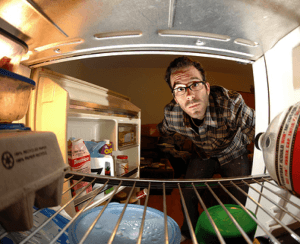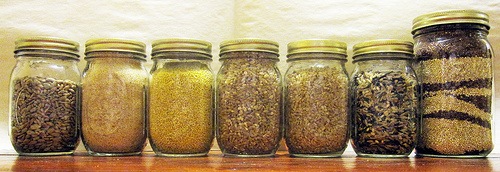 That’s the complaint.
That’s the complaint.
We stand at the refrigerator and stare at the contents. We rummage through the boxes and cans and bottles and jars in the pantry. We open drawers of spices and grains and close them again. There is all this food. But there’s nothing to eat!
“We need to go shopping.”
“Let’s go out!”
“Let’s order a pizza.”
“Call Dad and he’ll pick something up on the way home.”
Days later we’re dumping rotting produce, outdated rice boxes, dried out spices, and that half jar of pasta sauce at the back of the fridge all covered with mold. All the food that was sitting there when there was “nothing to eat”.
Why don’t we “see” this food? Why can’t we make a meal that doesn’t come in a box or rely on the exact ingredients in a familiar recipe? Is it just easier and more desirable to go out or order in? What makes our abundance invisible?
I’m blaming the kitchen!
I’ve been cooking differently lately. It started with Terry Walter’s great book CLEAN FOOD and its focus on eating well by choosing fresh seasonal food acquired close to the source. It got me thinking about the role of our kitchens in the journey from farm to fork. Here’s what I noticed.
First, we are so accustomed to the way kitchens are set up and used that we don’t even notice that we generate a lot of waste because, well – its easier to throw things away than to compost or recycle. And our storage is designed to stock boxes and cans and bags and jars of prepared foods, but not necessarily set up to bring home raw beans, nuts, seeds and grains and put them up or prepare them to use.
So I removed my trash can and discovered that it wasn’t so hard to redirect most “waste” back to nature or another use. I replaced most of our plastic containers with glass and discovered the aesthetic delights of seeing beans, nuts, seeds, and grains and recognizing just what was in the refrigerator – because I could see it. It’s a start.

Bit by bit fewer and fewer of the foods I eat are coming out of packages and more and more are “real” food. Maybe best of all, getting closer to the food has me comfortably assembling meals from my abundance in ways that may not fit a particular recipe; I’m just gathering what’s fresh and combining it in familiar ways. I thank Terry for teaching me that.
But now I have a job to do. If I’m going to blame the kitchen, I need to examine all my assumptions about how kitchens are designed and strive to imagine new ways to create kitchens that encourage us to see our food. We need to open our pantries and crack the fridge and roll out the drawers and say, “Look at all there is to eat!”
